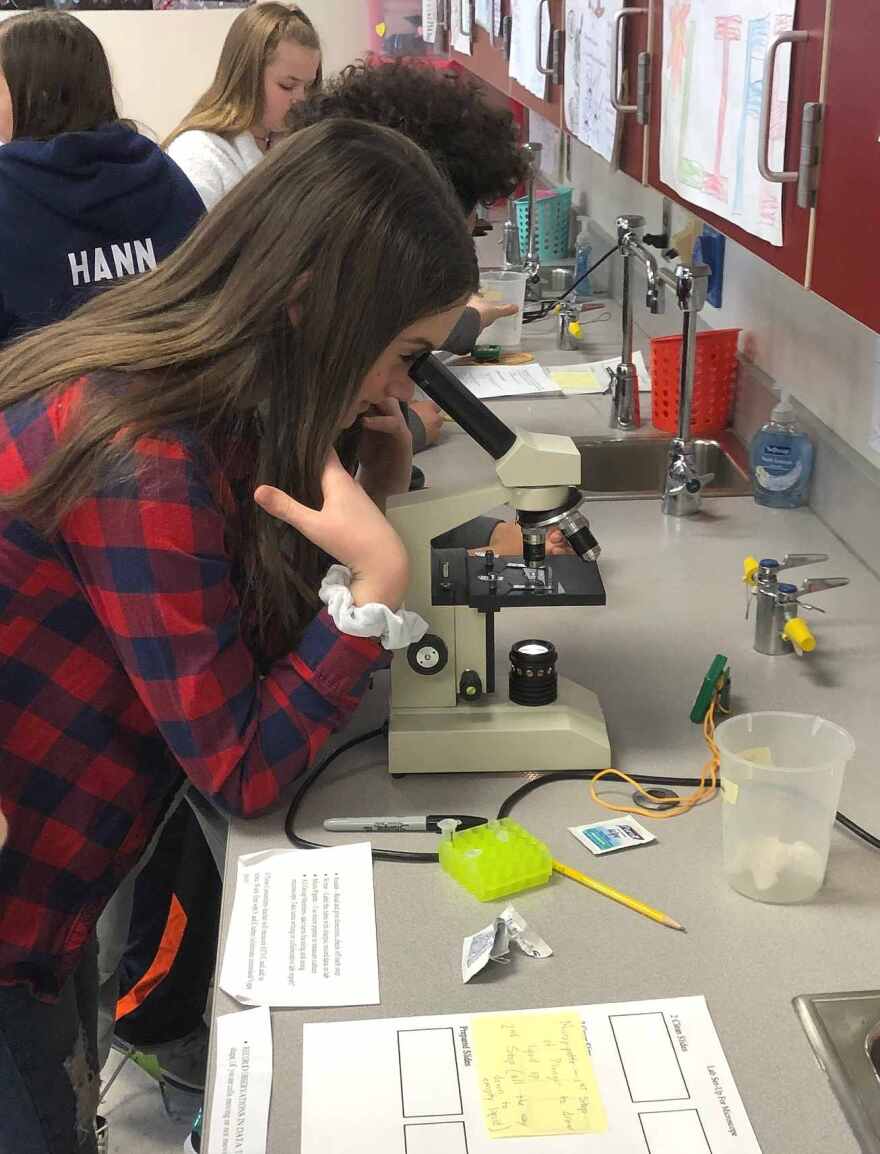The dangers E-cigarettes pose to young people are not fully known. But deaths and hospital visits due to vaping are raising concerns among parents and health experts, even as e-cigarette usage grows among younger and younger children. Now a health program at Cornell University has new way to open the eyes of youth to the potential dangers.
Students in Maggie Barrett’s 7th grade science class at West Genesee Middle School last month set up an experiment using microscopes and single cell organisms to see what vaping might do to our bodies.
Tetrahymena are single-celled organisms often used to test the impacts of something on human cells. Cornell University’s Dr. Donna Cassidy Hanley is senior research associate and developed the experiment for the Advancing Secondary Science Education through Tetrahymena (ASSET) program.

“We send them the re-condensed vape solution and we have them add it to the cells at a level that we know will have an effect. It's basically the equivalent of two to four puffs on an e-cigarette per cell group.”
Science teacher Barrett explains how here students utilized the materials sent by Cornell.
“We looked at tetrahymena without anything added. And then we looked at tetrahymena in which we added small e-vapor condensate.”
Barrett’s students set up the experiment themselves, and could see if the vapor, re-condensed after being vaped to simulate smoking it , was having any effect on the single cell organisms.
Cornell’s Cassidy-Hanley helped design the experiment initially to see impacts on cells from smoking and drinking alcohol. Now vaping is on the rise … and so are concerns about health impacts.
“And most of them don't even consider the idea that there might be other things in there that are harmful. For example, the e-cigarettes are not required to tell you what all their ingredients are. They can label their liquids, quote, ‘flavorants’ and flavorants can be almost anything they want them to be that will give flavor to their product. And so the kids see flavors and they think, ‘Oh, that's stuff you put in food, (it) must be safe.’”
And students don’t know what they’re getting into. An National Institutes of Health survey for example, found three quarters of high school sophomores didn’t know there was nicotine in many e-vapors.
As preparation for this experiment, students Devin Dantuono and Lorelei Leskoske learned about some of the potential dangers.
“So first of all, in the e-vapor, you have no clue where the stuff comes from. The vapor can be made in any country that doesn’t have health laws. There are traces of the chemical formaldehyde and sometimes little pieces of metal in the vape juice that can definitely cuse problems. It can cause headaches and lung disease and lot of problems,” said Dantuono.

“There’s this thing called tar that will get stuck in your chest,” added Leskoske. “The nicotine in it will affect how fast you start breathing and how your heart rate goes.”
STUDENT FINDINGS SHOW DRAMATIC IMPACTS ON THE SINGLE-CELL ORGANISMS
The eight or so student teams came away from their microscopes and shared what they found.
“Once we added the vapor (the cells) started moving slower and they also started throbbing. They started changing shapes,” said one of the student experimenters.
"As we put the vapor in they were still moving around a bit,” added another student. “But as the five minutes passed, some literally stopped moving. Sme, they actually split apart and died.”
Science teacher Maggie Barrett agrees this kind of hands-on learning makes a much greater impression than anything from a book or lecture.
“That’s the great thing about middle school science, there’s a lot of ‘ah ha’ moments. And I thnk they were surprised. They also had some misconceptions. Some didn’t realize the vapor isn’t just water.”
“The idea that they are getting to organize an experiment and actually carry out an experiment using these living cells. It's something that most kids really enjoy simply because it's something a little bit different from, from the everyday thing that they do in most of their classes. And then seeing that there's a direct effect on the cells generally has, it has an impact," said Cassidy-Hanley.
“The kids are seeing these cells swimming around, then all of a sudden they sink to the bottom of the drop and they don't move anymore. … That's a pretty impressive reaction for adding a little drop of liquid to some living organisms.”
She knows the one-time lesson can have only so much impact … but thinks the unique approach is worth it.
“The hope is that that we can reach at least some kids who maybe have heard their teachers and their parents and everybody else say vaping is bad for you and have just said, ‘yeah, but my peers are all doing it.’ … Whereas if they can do something with their hands and actually see this effect, hopefully we can reach a few more. I mean, it's not going, it's not going to be perfect. It's not going to … make every kid change their mind. But if we can reach a few, that would be great.”

And Barrett believes her students learned much more than the result of the experiment, that the vapor had a negative effect on the cells, and by extension could hurt their bodies.
“Hands-on learning is great and it’s always more meaningful. They acted like real scientists. They used tools of the scientist, microscopes, micro-pipettes, which we have never used. I think there were a lot of takeaways. They also collaborated and built 21st-century skills.”
The experiment is available to other schools. Cassidy Hanley and Cornell’s ASSET program will send the single-cell organisms and the e-cigarette vapor for the experiments, as well as test tubes, microscopes and slides – whatever the school needs based on the resources they already have.
In 2019, nearly 28 % of teens and 11 %of middle schoolers say they used e-cigarettes in the past 30 days. The unique learning opportunity is a response to that CDC information … that also showed 48 deaths and more than 2200 hospitalizations last year from vaping.
Vaping360 contributed to this story.



